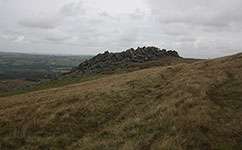Carn Goedog. Credit: Richard Bevins
A new study, published in the Journal of Archaeological Science, suggests that the site researchers had previously thought was the starting place of many of Stonehenge's rocks may not have been the source after all. Instead, it looks like the rocks actually come from a different site three kilometres away.
The findings, bring into question the long-standing theory that people transported the rocks from Wales to Wiltshire in order to build the monument.
The research focused on the smaller stones at Stonehenge, called bluestones. The chemistry of these rocks varies, but they all originate from the Preseli Hills in Wales and are thought to have been transported to the Stonehenge site over 4000 years ago.
By confirming the source of the rocks, the researchers hope to help answer the long standing question of how around 80 of these bluestones, weighing up to three tonnes each, were transported 250 kilometres from southwest Wales to Wiltshire.
'The Holy Grail question is how were the stones moved and why,' explains Dr Richard Bevins of National Museum of Wales who led the research. 'Many people think humans transported the stones south, down from the Preseli Hills and then up the Bristol Channel on rafts. But a second school of thought says these rocks are glacial erratics that were transported by ice to Salisbury Plain and so were available in the local environment.
'We're trying to discover the source of the stones so archaeologists can excavate sites in order to see if they can find evidence for people working the source stones,' he continues.
Scientists have known the bluestones originated from the Preseli Hills since 1923, when H. H. Thomas from NERC's British Geological Survey recognised the distinctive dark grey spotty rocks, known as spotted dolerites, during fieldwork. Further work in the early 1990s then tried to tie down the specific locations of the rocks' origin by matching the chemistry of the Stonehenge bluestones with those at the proposed origin site.
'The earlier research looked at the source of one of the spotted dolerites and tied it down to a specific outcrop, Carn Meini. It seems Thomas wanted all of the bluestones to also come from that same small area so he argued the rhyolites came from a nearby outcrop, Carn Alw. When we looked at it again we realised the descriptions of the rhyolites from Carn Alw and those at Stonehenge didn't look the same at all,' says Bevins.
The team took images showing the rocks at Stonehenge and the rocks at Carn Alw. They then asked members of the public with no geological background whether they looked the same.
'We asked people "does A look like B?" and everyone said no,' Bevins continues. 'This is astonishing because this has not been questioned since the original publication by Thomas in 1923.'
The team used a new method of identifying the chemical makeup of the rocks, to match the rocks with their origin. They believe that they have now identified Carn Goedog as the source of at least 55 per cent of the spotted dolerite bluestones at Stonehenge.
'If Carn Goedog is the true origin of the dolerites, and Craig Rhos-y-felin is a source of the rhyolitic bluestones then it does bring into question the stones being transported by rafts down to the Bristol Channel, because both of these outcrops lie on the northern side of the Preseli Hills. The rocks would have had to be dragged up the hills, across the summits and back down again before they even reached the waterways. It's just not likely,' Bevins concludes.
Journal information: Journal of Archaeological Science
Provided by PlanetEarth Online
This story is republished courtesy of Planet Earth online, a free, companion website to the award-winning magazine Planet Earth published and funded by the Natural Environment Research Council (NERC).






















